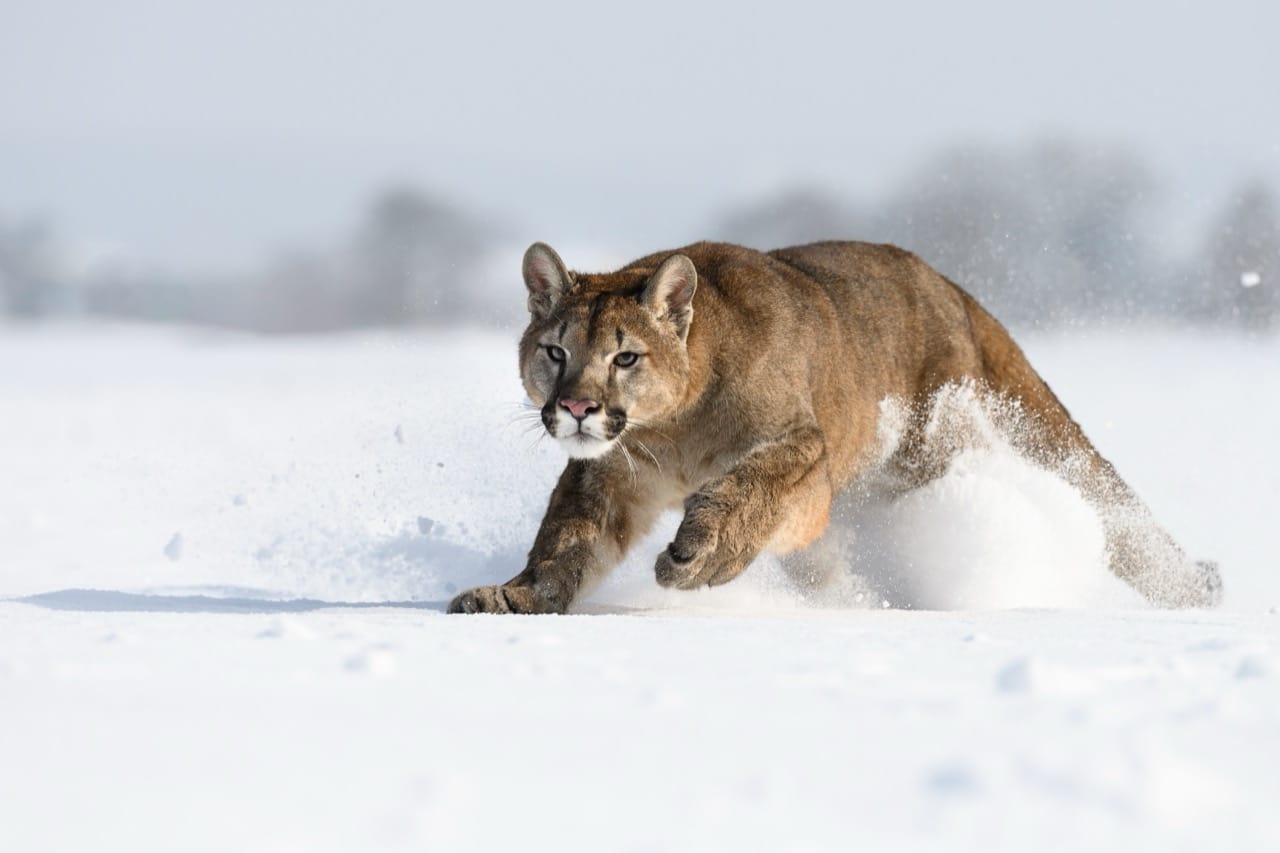In the heart of a snowy landscape, the cougar, also known as the mountain lion, emerges as a symbol of wild elegance and agile strength. This majestic feline, captured in mid-pounce against a backdrop of pristine white snow, epitomizes the raw beauty and the adaptability of North America’s formidable predator. Known for its powerful physique, elusive nature, and exceptional hunting skills, the cougar holds a revered place in both ecology and culture.
Characteristics / Physical Description
The cougar (Puma concolor) is a large felid with a body built for stealth and strength. Adult cougars typically weigh between 115 to 220 pounds, with males being larger than females. Their fur is a uniform tan or slightly grey color with lighter underparts, aiding in camouflage across diverse environments, from forests to rocky mountains. The cougar’s long, heavy tail, which measures almost one-third of its total body length, helps maintain balance, making it an adept climber and jumper. Their powerful limbs allow them to leap up to 18 feet in the air and cover distances up to 40 feet in a bound.
Taxonomy and Classification
Cougars belong to the family Felidae and are part of the genus Puma. The species name, concolor, means ‘of one color,’ which refers to their uniform fur coloration. Despite their varied common names like mountain lion, puma, and panther, all these refer to the same species, making the cougar one of the most widespread predators in the American continent.
Behavior and Social Structure
Cougars are solitary animals, with males and females only coming together briefly for mating. They are territorial; males maintain large territories that can overlap with several females. Cougars are crepuscular, most active during dawn and dusk, when their acute senses of vision and hearing make them formidable hunters. Communication among cougars is primarily through visual and olfactory signals; they scratch trees and use urine to mark their territory.
Habitat and Distribution
The cougar’s range is the most extensive of any wild terrestrial mammal in the Western Hemisphere, stretching from the Yukon in Canada to the southern Andes in South America. This adaptability to different habitats is remarkable, ranging from forests and mountainous areas to arid desert regions. Despite this wide range, habitat loss and conflict with humans have significantly reduced their northern and eastern boundaries.
Diet and Feeding Habits
As apex predators, cougars have a diet that primarily consists of deer, though they are opportunistic feeders. They can also hunt species as small as insects and as large as elk. They prefer to hunt alone, stalking their prey until an opportunity presents itself for a quick and powerful attack, usually targeting the neck to suffocate their prey.
Breeding and Reproduction
Cougars have a gestation period of approximately 91 days, resulting in a litter of one to six cubs, typically two or three. Born blind, the cubs are completely dependent on their mother and start to learn vital survival skills at around six weeks old. They remain with their mother for up to two years, during which they learn to hunt and fend for themselves.
Relationship with Humans
The relationship between cougars and humans has been fraught with challenges. While there is a certain admiration for these majestic creatures, they often come into conflict with human activities such as farming, leading to them being hunted or pushed out of their natural habitats. Conservation efforts are crucial for maintaining the delicate balance between human populations and cougar habitats.
Evolutionary History
Cougars are believed to have evolved in Asia about 11 million years ago before migrating to America. They share a common ancestor with the domestic cat and other big cats such as lions and tigers. Their evolutionary success is attributed to their adaptability and ability to survive in diverse climates and terrains.
Use as Research Animals
Research on cougars has provided valuable insights into their behavior, ecology, and interactions with ecosystems. They are often studied to understand predator-prey dynamics and their role in maintaining the health of various biomes.
The cougar remains one of the most powerful symbols of the untamed wilderness. As we continue to encroach on their territories, understanding and preserving this magnificent creature is not just about saving a species but about maintaining the health and balance of ecosystems across the Americas.

